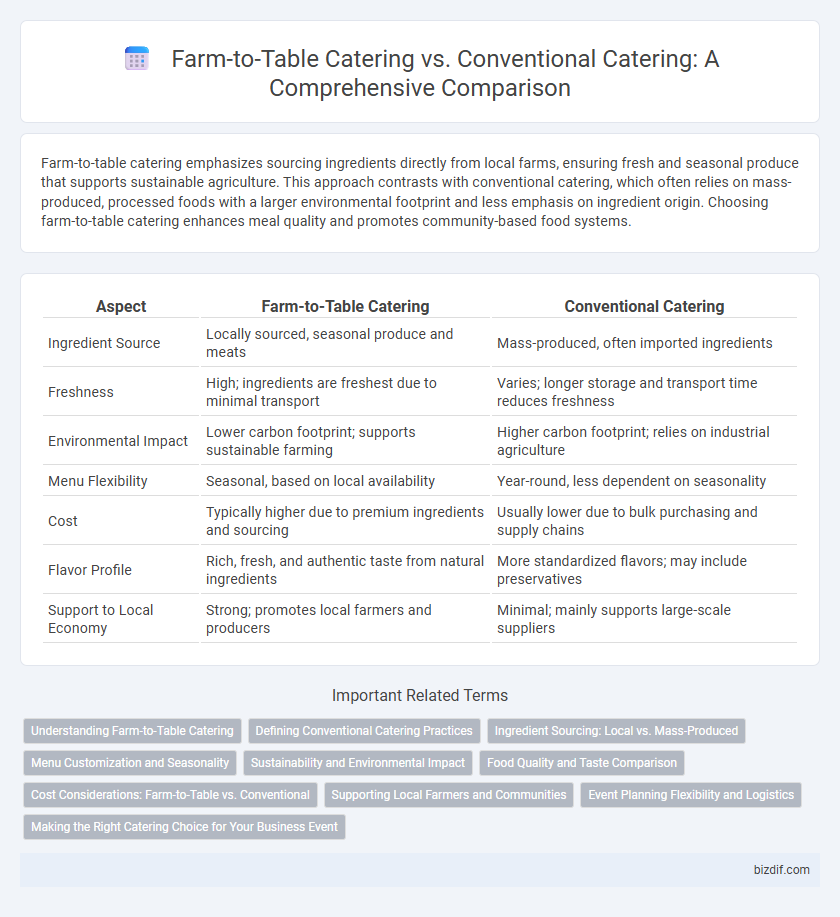Farm-to-table catering emphasizes sourcing ingredients directly from local farms, ensuring fresh and seasonal produce that supports sustainable agriculture. This approach contrasts with conventional catering, which often relies on mass-produced, processed foods with a larger environmental footprint and less emphasis on ingredient origin. Choosing farm-to-table catering enhances meal quality and promotes community-based food systems.
Table of Comparison
| Aspect | Farm-to-Table Catering | Conventional Catering |
|---|---|---|
| Ingredient Source | Locally sourced, seasonal produce and meats | Mass-produced, often imported ingredients |
| Freshness | High; ingredients are freshest due to minimal transport | Varies; longer storage and transport time reduces freshness |
| Environmental Impact | Lower carbon footprint; supports sustainable farming | Higher carbon footprint; relies on industrial agriculture |
| Menu Flexibility | Seasonal, based on local availability | Year-round, less dependent on seasonality |
| Cost | Typically higher due to premium ingredients and sourcing | Usually lower due to bulk purchasing and supply chains |
| Flavor Profile | Rich, fresh, and authentic taste from natural ingredients | More standardized flavors; may include preservatives |
| Support to Local Economy | Strong; promotes local farmers and producers | Minimal; mainly supports large-scale suppliers |
Understanding Farm-to-Table Catering
Farm-to-table catering emphasizes sourcing ingredients directly from local farms and producers, ensuring fresher, seasonal, and sustainably grown foods that enhance flavor and nutritional value. This approach reduces the carbon footprint associated with long-distance transportation and supports local economies, distinguishing it from conventional catering that often relies on mass-produced, processed, and imported ingredients. Understanding farm-to-table catering involves recognizing the commitment to transparency, quality, and environmental responsibility in meal preparation and service.
Defining Conventional Catering Practices
Conventional catering practices typically rely on mass-produced, non-local ingredients sourced through extensive supply chains, emphasizing efficiency and cost-effectiveness over freshness or sustainability. These methods often involve standardized menus and bulk purchasing, which can result in less seasonal variety and higher carbon footprints. The focus remains on meeting large-scale event demands with consistent, predictable offerings rather than prioritizing local agricultural partnerships or environmental impact.
Ingredient Sourcing: Local vs. Mass-Produced
Farm-to-table catering prioritizes ingredient sourcing from local farms, emphasizing fresh, seasonal, and sustainably grown produce that supports regional agriculture and reduces carbon footprint. Conventional catering relies heavily on mass-produced ingredients sourced from large suppliers, often resulting in less seasonal variety and higher environmental impact due to transportation and industrial farming practices. Choosing farm-to-table sourcing enhances meal quality and promotes eco-friendly dining experiences.
Menu Customization and Seasonality
Farm-to-table catering emphasizes menu customization by incorporating locally sourced, seasonal ingredients that highlight freshness and regional flavors. This approach allows caterers to create dynamic menus that adapt to seasonal availability, ensuring peak ingredient quality and sustainability. In contrast, conventional catering often relies on standardized menus with ingredients sourced from broad supply chains, limiting season-specific customization and freshness.
Sustainability and Environmental Impact
Farm-to-table catering emphasizes sourcing ingredients directly from local farms, significantly reducing transportation emissions and promoting seasonal, organic produce that supports biodiversity. This method minimizes packaging waste and energy consumption compared to conventional catering, which often relies on mass-produced, imported foods with higher carbon footprints. Prioritizing local supply chains, farm-to-table catering advances sustainability by fostering eco-friendly agricultural practices and reducing environmental impact.
Food Quality and Taste Comparison
Farm-to-table catering prioritizes fresh, locally sourced ingredients that enhance food quality through peak ripeness and minimal transportation time, resulting in vibrant flavors and superior taste. Conventional catering often relies on mass-produced or frozen ingredients, which can diminish freshness and lead to less flavorful dishes. The emphasis on seasonal produce in farm-to-table services ensures meals are consistently rich in natural taste and nutritional value.
Cost Considerations: Farm-to-Table vs. Conventional
Farm-to-table catering often incurs higher costs due to sourcing fresh, local, and seasonal ingredients, which can lead to increased menu prices compared to conventional catering that relies on bulk purchasing and processed foods. Conventional catering benefits from economies of scale and longer shelf-life products, reducing overall expenses and offering more budget-friendly options. Cost considerations should weigh the premium on quality and sustainability in farm-to-table options against the affordability and convenience of conventional catering services.
Supporting Local Farmers and Communities
Farm-to-table catering emphasizes sourcing ingredients directly from local farmers, promoting sustainable agriculture and strengthening regional economies. This approach reduces environmental impact by minimizing transportation while ensuring fresher, seasonal produce for clients. Conventional catering typically relies on mass-produced, often imported ingredients, which can undermine local farmers and limit community economic growth.
Event Planning Flexibility and Logistics
Farm-to-table catering emphasizes sourcing fresh, local ingredients, which can introduce seasonal menu variations and require tailored event planning to accommodate supplier availability. Conventional catering offers greater logistical predictability with standardized menus and bulk purchasing, facilitating streamlined scheduling and inventory management. Balancing farm-to-table freshness with event planning flexibility involves anticipatory coordination and adaptable logistics to ensure timely delivery and menu consistency.
Making the Right Catering Choice for Your Business Event
Farm-to-table catering prioritizes locally sourced, seasonal ingredients that enhance flavor and support sustainable agriculture, creating a fresh and authentic dining experience for business events. Conventional catering often relies on mass-produced ingredients with longer supply chains, potentially sacrificing quality and environmental impact for cost efficiency. Choosing farm-to-table catering can elevate your corporate event by showcasing commitment to health, sustainability, and community values, appealing to environmentally conscious clients and employees.
Farm-to-table catering vs conventional catering Infographic

 bizdif.com
bizdif.com